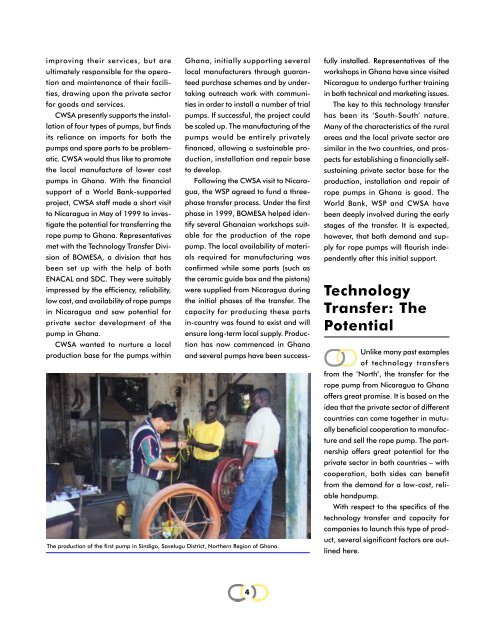improving their services, but are Ghana, initially supporting severalultimately responsible for the operation<strong>and</strong> maintenance of their faciliteedpurchase schemes <strong>and</strong> by under-local manufacturers through guaranties,drawing upon the private sector taking outreach work with communitiesin order to install a number of trialfor goods <strong>and</strong> services.CWSA presently supports the installationof four types of pumps, but finds be scaled up. <strong>The</strong> manufacturing of thepumps. If successful, the project couldits reliance on imports for both the pumps would be entirely privatelypumps <strong>and</strong> spare parts to be problematic.CWSA would thus like to promote duction, installation <strong>and</strong> repair basefinanced, allowing a sustainable pro-the local manufacture of lower cost to develop.pumps in Ghana. With the financial Following the CWSA visit to Nicaragua,the WSP agreed to fund a three-support of a World Bank-supportedproject, CWSA staff made a short visit phase transfer process. Under the firstto Nicaragua in May of 1999 to investigatethe potential for transferring the tify several Ghanaian workshops suit-phase in 1999, BOMESA helped iden-rope pump to Ghana. Representatives able for the production of the ropemet with the Technology Transfer Divisionof BOMESA, a division that has als required for manufacturing waspump. <strong>The</strong> local availability of materi-been set up with the help of both confirmed while some parts (such asENACAL <strong>and</strong> SDC. <strong>The</strong>y were suitably the ceramic guide box <strong>and</strong> the pistons)impressed by the efficiency, reliability, were supplied from Nicaragua duringlow cost, <strong>and</strong> availability of rope pumps the initial phases of the transfer. <strong>The</strong>in Nicaragua <strong>and</strong> saw potential for capacity for producing these partsprivate sector development of the in-country was found to exist <strong>and</strong> willpump in Ghana.ensure long-term local supply. Productionhas now commenced in GhanaCWSA wanted to nurture a localproduction base for the pumps within <strong>and</strong> several pumps have been success-<strong>The</strong> production of the first pump in Sindigo, Savelugu District, Northern Region of Ghana.fully installed. Representatives of theworkshops in Ghana have since visitedNicaragua to undergo further trainingin both technical <strong>and</strong> marketing issues.<strong>The</strong> key to this technology transferhas been its ‘South-South’ nature.Many of the characteristics of the ruralareas <strong>and</strong> the local private sector aresimilar in the two countries, <strong>and</strong> prospectsfor establishing a financially selfsustainingprivate sector base for theproduction, installation <strong>and</strong> repair ofrope pumps in Ghana is good. <strong>The</strong>World Bank, WSP <strong>and</strong> CWSA havebeen deeply involved during the earlystages of the transfer. It is expected,however, that both dem<strong>and</strong> <strong>and</strong> supplyfor rope pumps will flourish independentlyafter this initial support.TechnologyTransfer: <strong>The</strong>PotentialUnlike many past examplesof technology transfersfrom the ‘North’, the transfer for therope pump from Nicaragua to Ghanaoffers great promise. It is based on theidea that the private sector of differentcountries can come together in mutuallybeneficial cooperation to manufacture<strong>and</strong> sell the rope pump. <strong>The</strong> partnershipoffers great potential for theprivate sector in both countries – withcooperation, both sides can benefitfrom the dem<strong>and</strong> for a low-cost, reliableh<strong>and</strong>pump.With respect to the specifics of thetechnology transfer <strong>and</strong> capacity forcompanies to launch this type of product,several significant factors are outlinedhere.4
THE TRANSFERPROCESS<strong>The</strong> transfer process from Nicaraguato Ghana consisted of threephases.Phase I (November 15 to November26, 1999):Technical assistance provided viacorrespondence <strong>and</strong> a two-weekvisit by BOMESA to the Ghanaianauthorities to help with selectionof suitable manufacturers, confirmthe availability of materials, supplytechnology transfer manuals,<strong>and</strong> help commence production.Phase II (February 7 to February10, 2000):BOMESA hosted two Ghanaiantechnicians in Nicaragua for furthertraining, dealing with the automatizationof production, marketingtechniques <strong>and</strong> financialmanagement.Phase III (June 19 to June 30,2000):Installation of the trial-run of 100pumps in Ghana, further technicalassistance from BOMESA coveringquality control, br<strong>and</strong>ing <strong>and</strong>steps to develop a durable relationshipbetween the Nicaraguan<strong>and</strong> Ghanaian manufacturers.This phase is to be followed by anevaluation of the pump’s localacceptance <strong>and</strong> performance inearly 2001.Institutional climate<strong>The</strong> favorable institutional climatewas a key element in the successfulemergence of the pump in Nicaragua<strong>and</strong> is important in determining thepotential for a successful transfer elsewhere.Resistance from the governmentor other agencies makes it verydifficult for sustainable private sectorprovision to take root.SupplyA local supply chain needs to be createdwith demonstrable links to thecommunity. It should also be shortenough so that rope pump manufacturingwill form an important part ofrevenue <strong>and</strong> encourage long-termcommitment by the supplier. Given thelow technology nature of the pump, theappropriate pump manufacture materialsshould be easily available in thecountry. Installation <strong>and</strong> repair requirementsalso need consideration, with theNicaraguan example providing a usefulmodel.Due to the simplicity of the pump, aspecific supply chain for spare parts isnot required. A majority of the partscan usually be found at the local groceror hardware shop.Quality controlQuality control of the raw materials,manufacturing, <strong>and</strong> the installationof the pump are key elements of success.A st<strong>and</strong>ard of quality should beagreed to <strong>and</strong> applied by the principalproducers in a country/region. <strong>The</strong>experience in Nicaragua has shownthat inferior reproductions of the pumpby ‘artisans’ that are cheaper <strong>and</strong>below st<strong>and</strong>ard can damage the reputationof the pump (see Supply ChainsSeries No.1: <strong>The</strong> Treadle <strong>Pump</strong>: AnNGO Introduces a Low-cost Irrigation<strong>Pump</strong> to Bangladesh).Dem<strong>and</strong>A WSP study Rural <strong>Water</strong> Supply inNicaragua: <strong>The</strong> <strong>Rope</strong> <strong>Pump</strong> indicatesthat dem<strong>and</strong> should be high whereverthere are a large number of lowincomerural households with no accessto piped distribution water. A traditionof using family wells for drinking wateris helpful, as this will facilitate ropepump adoption <strong>and</strong> lower the capitalcost where existing wells can be used.Evidence also indicates that in thebeginning the role of state extensionagencies, NGOs, <strong>and</strong> donors will beextremely important in mobilizingdem<strong>and</strong> for the pump. BOMESA stressesthat a successful trial installation, withproduct quality assured <strong>and</strong> followed bymarketing <strong>and</strong> information campaigns,is of great importance. Dem<strong>and</strong> mustprove sustainable once initial supportis withdrawn.FinancingFinancing <strong>and</strong> willingness to pay forproducers is critical to the success ofthe transfer. If manufacturers requireseed capital, governments or donorscould provide this. This should takeplace preferably in the initial phasesonly. In Ghana a guaranteed initialpurchase provided the incentive todevelop initial production capacity.<strong>The</strong> need for independent costrecovery by the private operators cannotbe overstated. If this is onlyachieved through distortions in themarket, due to government or donorintervention, then production willremain dependent upon such distortions.Support to marketingMarketing <strong>and</strong> promotion areextremely important in establishing thedem<strong>and</strong> for the pump. To promotesustainability, the manufacturer shouldincorporate costs of marketing into theprice of the pump. Careful br<strong>and</strong>ingis also important. However, a large5
















